
Mussel is the common name used for members of several families of bivalve molluscs, from saltwater and freshwater habitats. These groups have in common a shell whose outline is elongated and asymmetrical compared with other edible clams, which are often more or less rounded or oval.

Bivalvia, in previous centuries referred to as the Lamellibranchiata and Pelecypoda, is a class of marine and freshwater molluscs that have laterally compressed bodies enclosed by a shell consisting of two hinged parts. As a group, bivalves have no head and they lack some usual molluscan organs, like the radula and the odontophore. The class includes the clams, oysters, cockles, mussels, scallops, and numerous other families that live in saltwater, as well as a number of families that live in freshwater. The majority are filter feeders. The gills have evolved into ctenidia, specialised organs for feeding and breathing. Most bivalves bury themselves in sediment, where they are relatively safe from predation. Others lie on the sea floor or attach themselves to rocks or other hard surfaces. Some bivalves, such as the scallops and file shells, can swim. Shipworms bore into wood, clay, or stone and live inside these substances.

A byssus is a bundle of filaments secreted by many species of bivalve mollusc that function to attach the mollusc to a solid surface. Species from several families of clams have a byssus, including pen shells (Pinnidae), true mussels (Mytilidae), and Dreissenidae.

Sea silk is an extremely fine, rare, and valuable fabric that is made from the long silky filaments or byssus secreted by a gland in the foot of pen shells. The byssus is used by the clam to attach itself to the sea bed.

The Pteriomorphia comprise a subclass of saltwater clams, marine bivalve molluscs. It contains several major orders, including the Arcida, Ostreida, Pectinida, Limida, Mytilida, and Pteriida. It also contains some extinct and probably basal families, such as the Evyanidae, Colpomyidae, Bakevelliidae, Cassianellidae, and Lithiotidae.
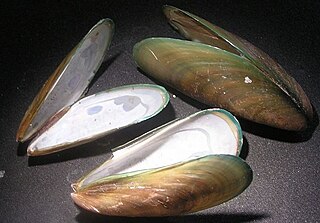
Mytilida is an order of marine bivalve molluscs, commonly known as true mussels. There is one extant superfamily, the Mytiloidea, with a single extant family, the Mytilidae.

Atrina fragilis, the fan mussel, is a species of large saltwater clam, a marine bivalve mollusc in the family Pinnidae, the pen shells.

The Pinnidae are a taxonomic family of large saltwater clams sometimes known as pen shells. They are marine bivalve molluscs in the order Pteriida.
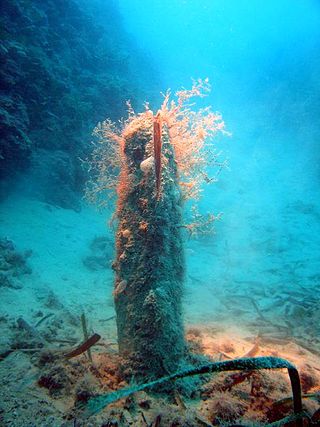
Pinna is a genus of bivalve molluscs belonging to the family Pinnidae.

Atrina is a cosmopolitan genus of bivalve molluscs belonging to the family Pinnidae.

Atrina rigida, commonly called the rigid pen shell, is a species of bivalve mollusc in the family Pinnidae.

Mytilus is a cosmopolitan genus of medium to large-sized edible, mainly saltwater mussels, marine bivalve molluscs in the family Mytilidae.
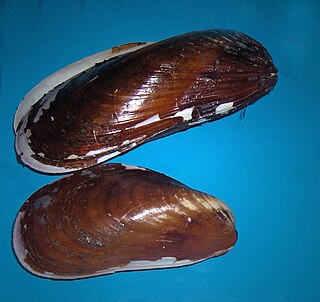
Modiolus modiolus, common name northern horsemussel, is a species of marine bivalve mollusk in the family Mytilidae.
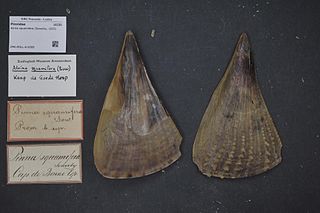
Atrina squamifera, one of several species known as the horse mussel, is a species of bivalve pen shell. It is a marine mollusc in the family Pinnidae. It is endemic to South Africa.

Pinna carnea, commonly called the amber pen shell, is a species of bivalve mollusc in the family Pinnidae.

Pinna rudis, the rough pen shell or spiny fan-mussel, is a species of bivalve mollusc in the family Pinnidae. It is the type species of the genus Pinna. Knowledge about this is sparse, with an absence of specific studies and literature.
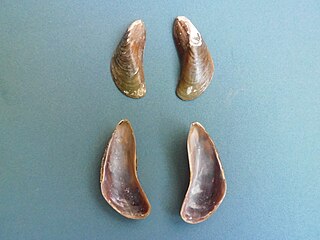
Mytella charruana is a bivalve, commonly known as the charru mussel. This species was discovered in Central and South America and by Alcide d'Orbigny, a French naturalist, in 1842. They are less than an inch long (2.5 cm), and range from brown to black in color.

Pinna bicolor, also known as razorfish, razor clam, or pen shell, is a species of large saltwater clam in the family Pinnidae. It is commonly found in shallow waters up to 50 m (160 ft) deep. It can be found embedded in firm muddy intertidal sediments, seagrass beds, and reef flats along continental and island shores.

Pinna muricata is a species of bivalves belonging to the family Pinnidae.



























